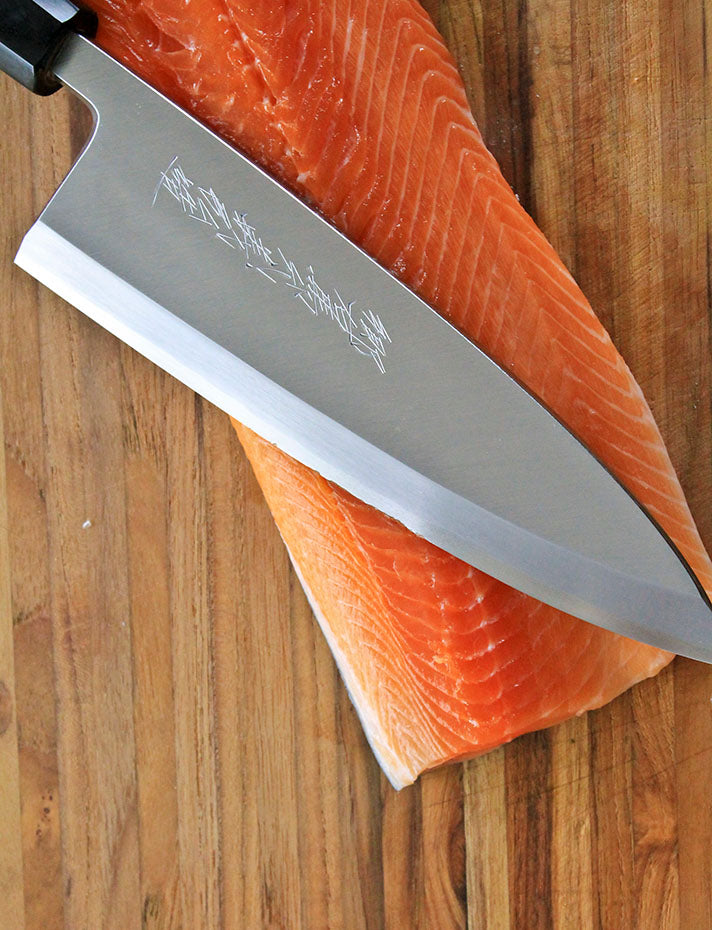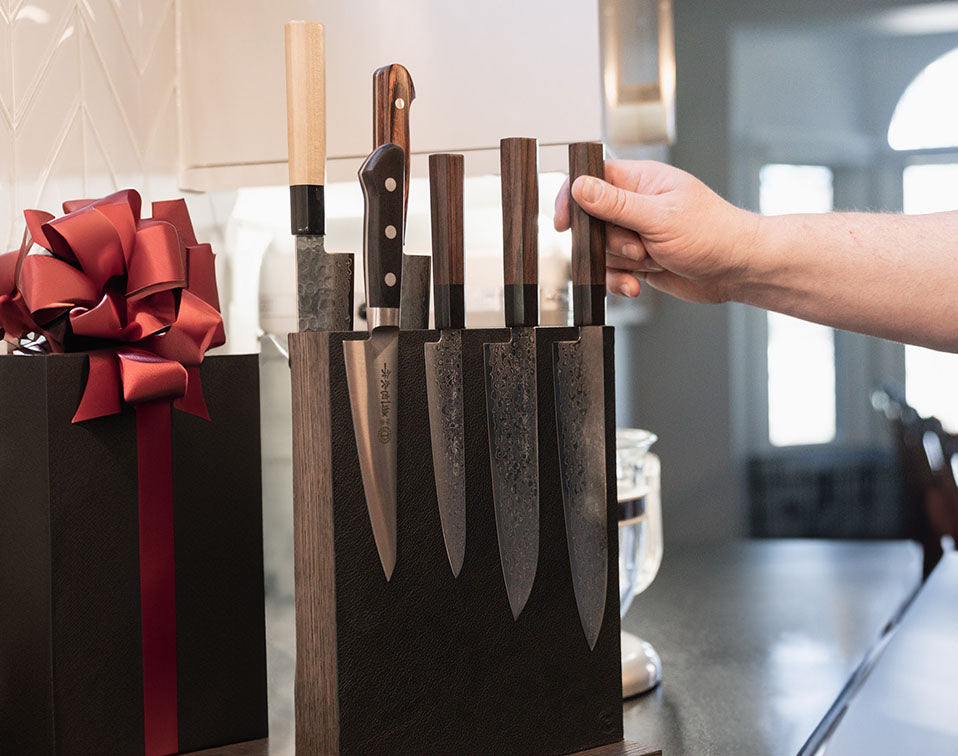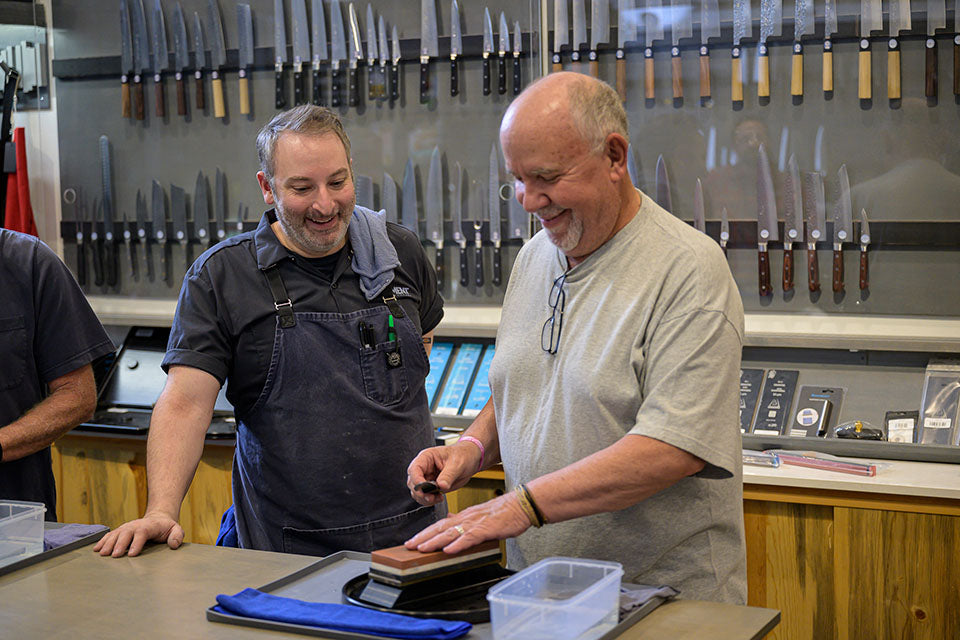Steel Types And Metallurgy 101
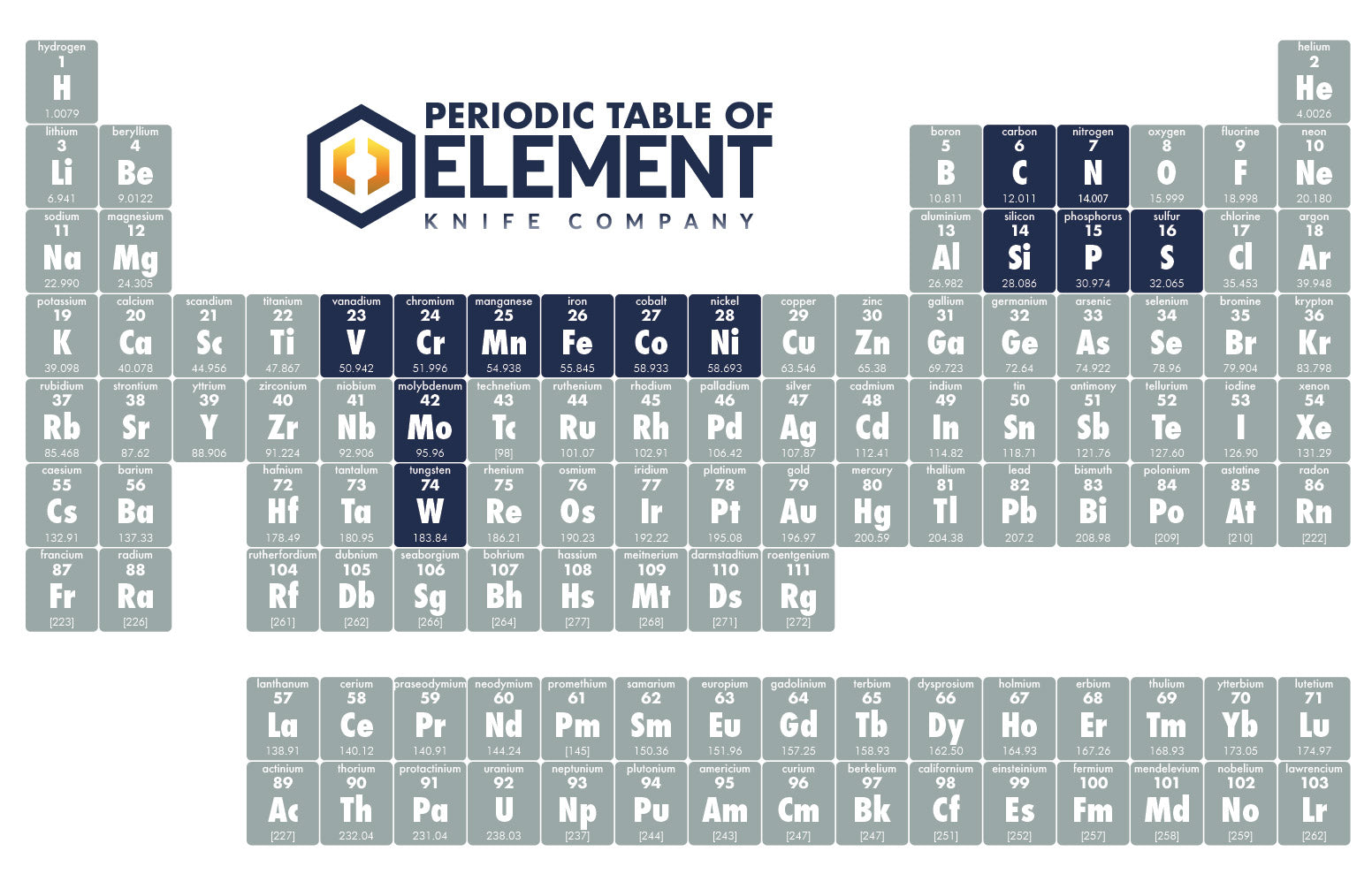
Click Each To Learn More
Common Knife Steels
Carbon Steel
Carbon steel has a carbon content ranging from 0.05% to 2.1% by weight. Carbon steel is hard, meaning great edge retention. It also takes an extremely keen edge. Furthermore, carbon steel is very responsive to sharpening stones because it lacks chromium (Unless the knife becomes very dull). Then, because it is a hard material, it takes a lot of effort to reestablish the bevel. Carbon steel is not stainless, and it is very reactive to anything with an acidic pH. So, more care and effort should be taken to keep it from rusting. It is recommended to cultivate a healthy patina, as this will help act as a protectant against rust.
Semi-Stainless
Semi-Stainless Steel is much like high-carbon steel but with a moderate amount of chromium added. It will tarnish more slowly than carbon steel. Since the blade is not stainless, it is still recommended to cultivate the patina to help protect the blade’s surface.
Stainless Steel
Stainless Steel is achieved by the addition of at least 10.5% Chromium by weight. This science is almost magical. Chromium molecules bond with Oxygen molecules from the air. This forms Chromium Oxide, a clear hard skin that adheres to the steel. Knives made from stainless steel don’t require as much care. Take note that any stainless steel can rust in adverse conditions.
Powdered Steel
Powdered High Speed Tool Steel, sometimes called Particle Steel, or referred to as Powdered Metallurgy, is a specialty steel manufacturing process. Although manufacturers have their own proprietary methods, essentially the process involves superheating steel to liquefy it. It is then ejected through a fine nozzle into liquid nitrogen. The quick cooling atomizes the steel resulting in a uniform powder. The powdered steel then goes through a process of putting immense pressure from all sides, known as isostatic pressure, Hot Isostatic Pressure (HIP). Finally, the powdered steel is brought up to forging temperatures and formed into billets of carbon or stainless steels that can then be forged. This manufacturing process provides benefits in most areas. Such as increased wear resistance, increased toughness (better for chipping), better grindability & enhanced finishes. Powdered metallurgy grants bladesmiths the ability to heat treat knives to a harder rating on the HRC Rockwell Scale. Another benefit of Powdered Steel is that the elements are more evenly distributed in the alloy.
Steel Types And Metallurgy 101
Carbon Steels
Delve into the world of carbon steels with this section dedicated to unraveling the complexities and attributes of various carbon steels used in kitchen knives. This guide explores their unique properties, including hardness, edge retention, and sharpening ease, to help you understand and choose the best steel type for your culinary needs.
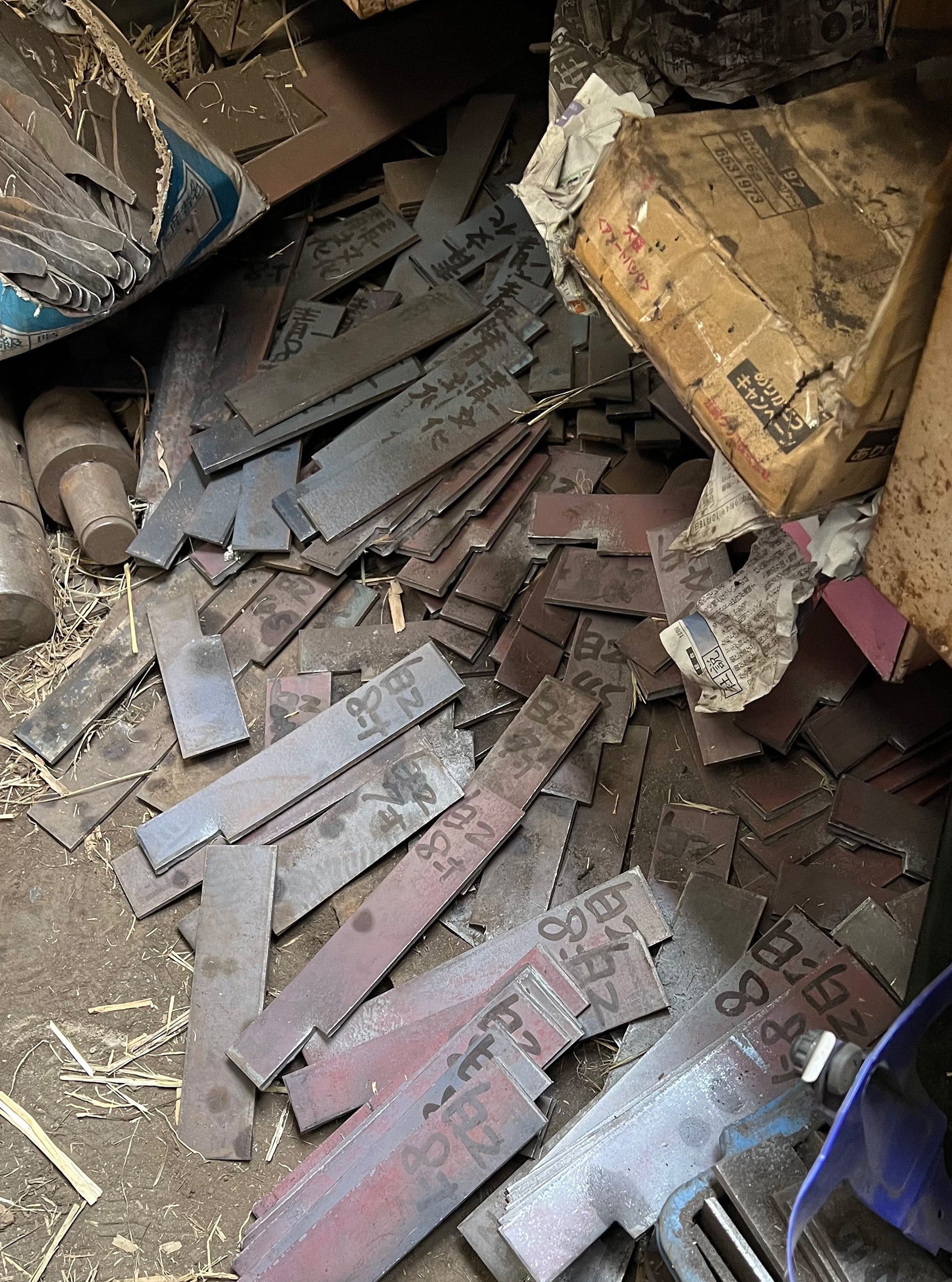
Carbon Steels
White Steel, also known as White Paper Steel, Shiroko, or Shirogami
Named White Paper Steel because of the color paper wrapped around the billets of steel when manufactured at the Hitachi factory in Yasugi City, Shimane Prefecture, Japan. White steel is fine-grained and very pure, with few contaminants. This means it has a very narrow range of temperatures for hardening and quenching (which requires an extremely skilled blacksmith). White steel is quite reactive and prone to surface rust, requiring a higher level of care. Nonetheless, it is loved by chefs because it is easy to achieve a razor-sharp edge that lasts.
Grades:
- Shiroichiko
- Shironiko
- Shirosanko
Click Each To Learn More
White Steels
Shiroichiko #1
- It has the highest carbon content, offering the longest edge retention, but it is most brittle.
- 63 HRC
- C 1.25-1.35% | Mn 0.20-0.30% | P 0.03% | S 0.004% | Si 0.10-0.20%
Shironiko #2
- It is very common and less prone to chipping. It’s a popular choice due to a very good edge retention and easy sharpenability.
- 61-62 HRC
- C 1-1.15% | Mn 0.20-0.30% | P 0.03% | S 0.004% | Si 0.10-0.20%
Shirosanko #3
- Is the most chip resistant (tough), but has shorter edge retention.
- 60 HRC
- C 0.80-0.90% | Mn 0.20-0.30% | P 0.03% | S 0.004% | Si 0.10-0.20%
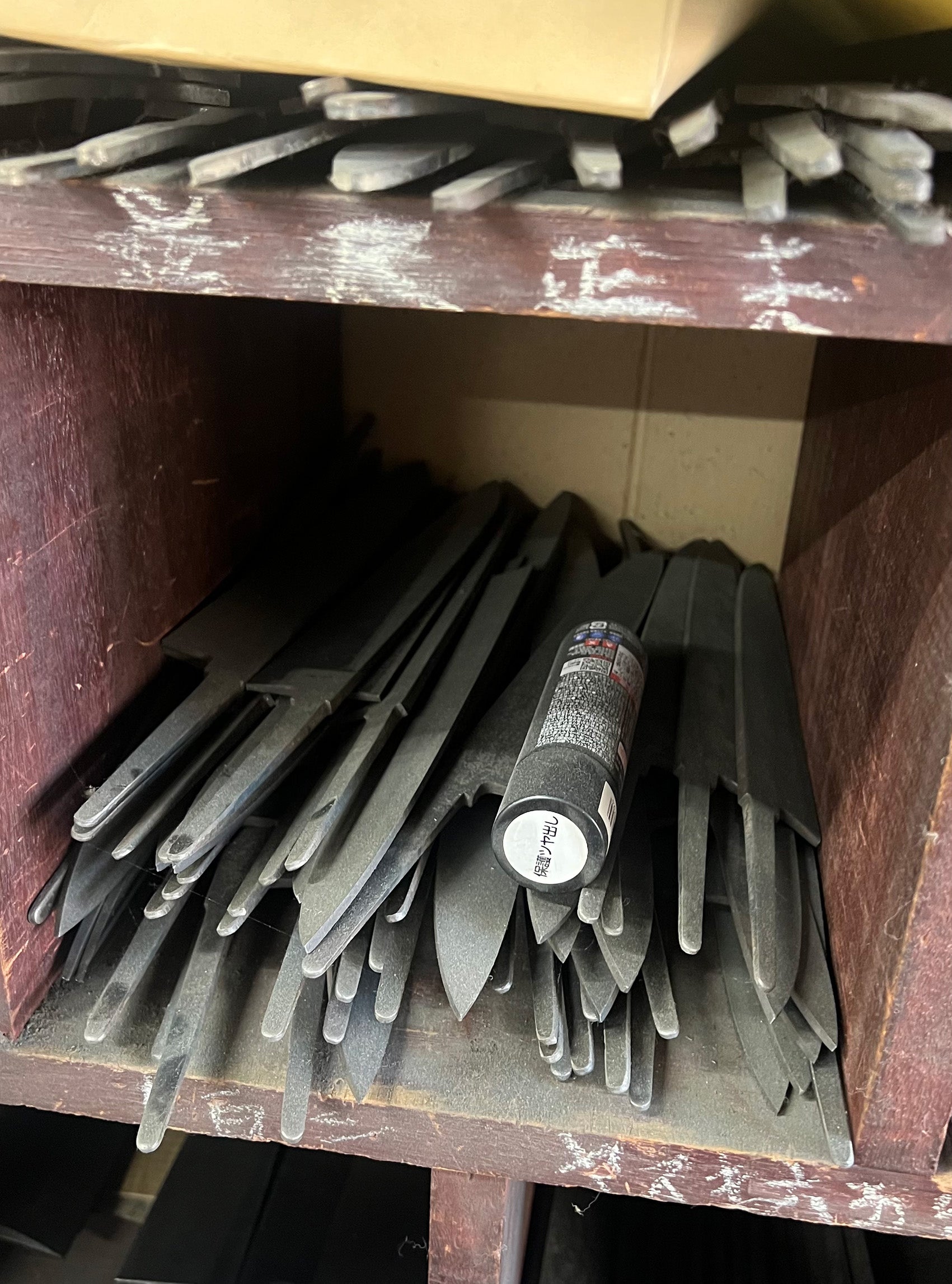
Carbon Steels
Blue Steel, also known as Blue Paper Steel, Aoko, or Aogami
Blue steel gets its name, same as White Steel since blue paper is wrapped around the billets of steel while manufactured at the Hitachi factory in Japan. Inherently, fine-grained, high in Carbon and low in contaminants, blue steels are made from the same iron stock that white steels are made from. What separates blue steel from white steel is the addition of Chromium and Tungsten. The addition of these elements produces Carbide formation and greater edge retention.
Grades:
- Aoichiko
- Aoniko
- Super, Aogami Super, Blue Super
Click Each To Learn More
Blue Steels
Aoichiko #1
- Great edge retention with a smooth cutting feel.
- 61-64 HRC
- C 1.25-1.35% | Cr 0.20-.50% | Mn 0.20-0.30% | P 0.03% | S 0.004% | Si 0.10-0.20%
Aoniko #2
- Is very common for Japanese double-bevel knives.
- 61-62 HRC
- C 1.05-1.15% | Cr 0.20-.50% | Mn 0.20-0.30% | P 0.03% | S 0.004% | Si 0.10-0.20% | W 1.00-1.58%
Blue Super
- Not only does Blue Super have added Chromium and Tungsten, it also has Vanadium and Molybdenum which promote wear resistance, toughness, & corrosion resistance. Blue Steel has fantastic edge retention.
- 61-65 HRC
- C 1.40-1.50% | Cr 0.30-.50% | Mn 0.20-0.30% | Mo 0.30-0.52% | P 0.03% | S 0.004% | Si 0.10-0.20% | W 2.00-2.50% | V 0.30-0.50%

Carbon Steels
Yellow Steel, also known as Yellow Paper Steel, or Kigami
Yellow Steel also gets its name from the yellow paper wrapped around the billets of steel while produced at the Hitachi factory in Japan. Although it has high Carbon content, it has more impurities than White and Blue steels. Yellow Paper Steel is often used for high-end tools, saw blades and low- to mid-class knives. Even though Yellow Paper Steel has a similar HRC to Blue and White Steels, its higher level of contaminants don’t match the favorable attributes exhibited by higher-end more refined steels.
SK- 4
Manufactured by the Hitachi Factory in Japan, this family of steel is more economically priced. This steel has higher amounts of phosphorus and sulfur than other high-carbon steels. It tends to be more reactive and a patina will quickly develop. SK-4 has a 61-62 HRC and is a workhorse.
C 0.95-1.04% | Si 0.15-0.35% | Mn 0.15-0.5% | P 0.03% | S 0.03% | Cr 0.3% | Ni 0.25% | Cu 0.25%
52100 Ball Bearing Steel
52100 steel is a simple Carbon Alloy Steel created circa 1905, with origins out of Germany. Its development derived from the need for a bearing steel for high-pressure applications. In recent years, it has become very popular for blade steel. 52100’s addition of Chromium increases hardenability, reduces carbide size, and increases toughness.
C 0.98-1.10% | Cr 1.30-1.60% | Mn 0.25-0.45%
Steel Types And Metallurgy 101
Stainless Steels
Explore the resilient world of stainless steels in the next section. This brief overview introduces you to the variety of stainless steel types used in kitchen knives, highlighting their corrosion resistance, maintenance ease, and overall durability. Gain insight into how stainless steel compares to carbon steel in terms of performance and suitability for different culinary tasks, helping you make an informed decision for your kitchen toolkit.
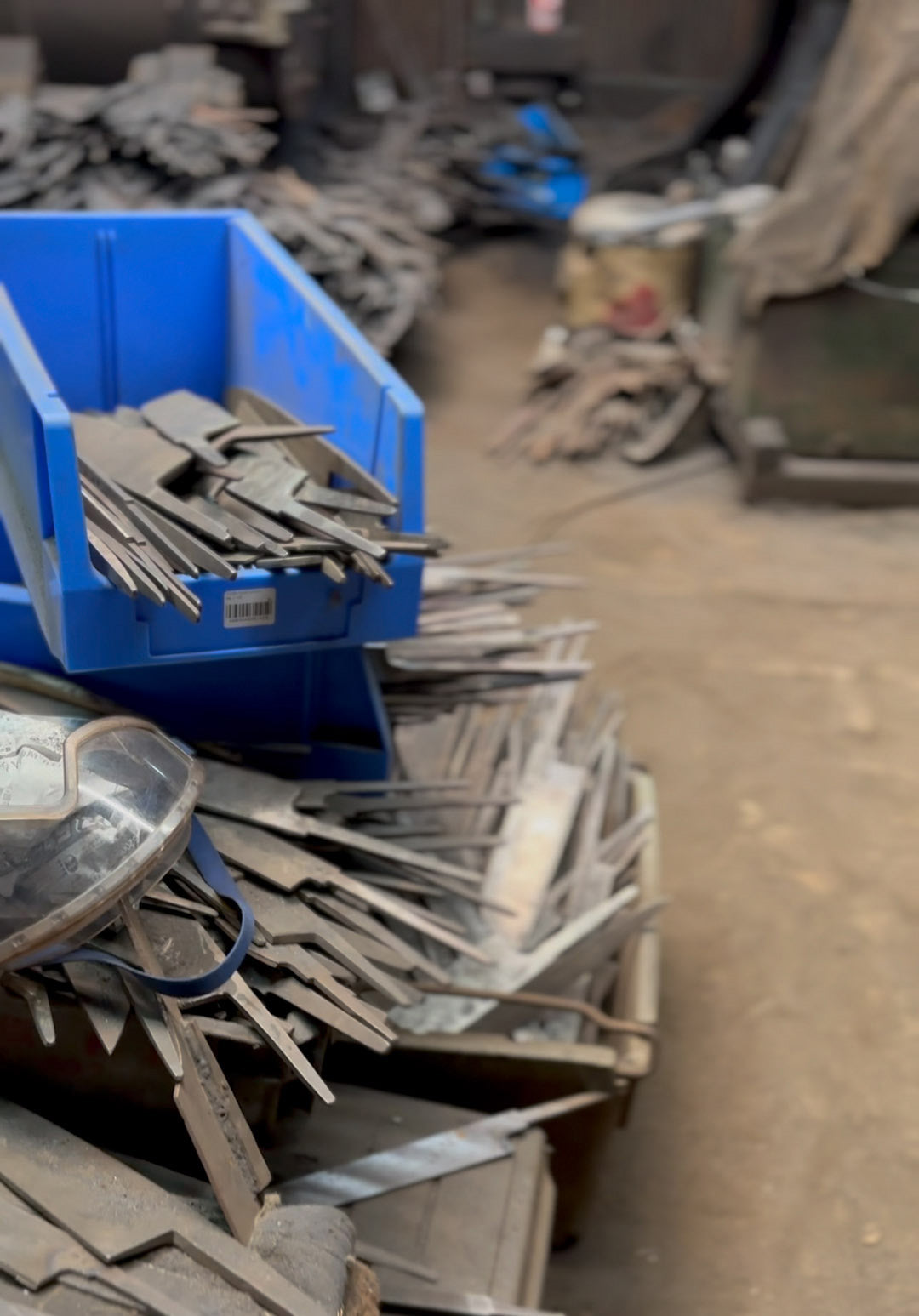
Stainless Steels
AUS-6, AUS-8, & AUS-10
This upper range stainless steel is produced in Japan by the Aichi Steel Corporation. It is popular among bladesmiths since it exhibits sought after qualities in a knife. Ease of sharpening, extended edge retention, flexibility, and great wear resistance. Its high performance and low cost are other attractive attributes. Typically these steels fall between 58-60 on the Rockwell Scale. The high Chromium content in the AUS series, along with its well rounded composition of elements, such as Molybdenum and Vanadium allow blades to become razor sharp, hold their edge, and sharpen easily.
Click Each To Learn More
AUS Series Steels
AUS-6
- Has a lower Carbon content & is usually considered a lower quality steel. Generally you will not find cutlery made from AUS-6.
- 57-58 HRC
- C 0.55-0.65% | Cr 13.14.5% | Mn 1.00% | V 0.10-0.25% | Ni 0.50% | Si 1.00%
AUS-8
- Has a slight increase of Carbon along with increased amounts of Vanadium, making great wear resistance & edge retention.
- 57-59 HRC
- C 0.70-0.75% | Cr 13.14.5% | Mn 0.50% | V 0.10-0.26% | Ni 0.50% | Mo 0.10-0.30% | Si 1.00%
AUS-10
- Has the highest amount of Carbon in the series, giving it higher wear resistance & edge retention than AUS-8
- 58-61 HRC
- C 0.95-1.05% | Cr 13.14.5% | Mn 0.50% | V .10-0.27% | Ni 0.50% | Mo .10-.31% | Si 1.00
Click Each To Learn More
More Stainless Steels
VG-10
VG-10, sometimes called V-Kin (Kin in Japanese is gold), was created by Takefu Special Steel Co. Ltd in Takefu, Fukui prefecture in Japan. Considered one of the highest levels of stainless steels. It has a high carbon content, making the steel a very hard Rockwell rating of 60-62. The special combination of its elements gave rise to the name VG-10. The G stands for ‘Gold’ in reference to the ‘Gold Standard’ that this stainless steel is considered to be. It is extremely popular among chefs and food enthusiasts because of its ability to hold an edge, withstand rust and has a high level of durability. Not to be confused with VG-1, which is a capable stainless steel in and of itself.
C .96-1.05% | Cr 14.5-15.5% | V 0.10-.30% | Co 1.3-1.8% | Mo 0.9-1.2% | Co 1.30-1.50% | Mn 0.50%
VG-1
Sometimes called V-Gold, it is the predecessor to VG-10. Also produced by Takefu Special Steel Co. Ltd in Takefu, Fukui prefecture in Japan. This high carbon stainless steel has elements of chromium, and molybdenum, which during forging, produce hard double carbide bonds. This creates abrasion and corrosion resistance. After heat treating, VG-1 ranges from 58-61 on the Rockwell Scale. VG-1 does not have vanadium, making it less wear resistant but does have nickel, which makes it tougher. It holds its edge and is easy to sharpen.
C .96-1.05% | Cr 13-15% | V 0.25-.35% | Co 1.3-1.8% | Mo 0.2-.40% | Ni 0.25%
Ginsan-Ko
Sometimes referred to as Gin-3, Ginsan or Silver-3. Produced by the Hitachi factory in Yasugi City, Shimane Prefecture, Japan. With 13.00 ~ 14.5% Chromium, it was created to produce stainless knives that function like high-carbon steel. It has a high carbon content of 0.92 ~ 1.10%, producing a steel with excellent sharpenability. Usually it ranks at 59-62 on the Rockwell scale and has a cutting feel and ease of sharpening similar to Shirogami carbon steel.
C .95-1.10% | Cr 13-14.50% | Mn 0.60-1.00% | Mo 1.0-2.0% | P 0.03% | Si 0.35%
Sandvik 19c27 Swedish Steel
Sweden is known to have extremely high-quality iron ore deposits. These very pure deposits also contain small percentages of other metal ores, making it a natural alloy. The Swedish steel industry has a long history spanning from as far back as the middle ages. Swedish steel is popular with Japanese blade-smiths due to its predictable nature and fine carbide microstructure. After heat treatment, Swedish steel exhibits high toughness, corrosion resistance, great edge retention, 60-66 HRC, and extreme sharpness.
C 0.95% | Cr 13.5% | Mn 0.70% | P 0.03% | S 0.01% | Si 0.40%
1.4116 German Steel
Is a common stainless steel for German cutlery. Often referred to as X50CRMOV15, it is widely regarded for its stainless properties, toughness, and great mechanical attributes. Produced by ThyssenKrupp. It’s comparable to AUS Steel, but has more Chromium, 15%, increasing its stain resistance. Added Molybdenum increases hardenability. Vanadium promotes a fine grain structure. Manganese gives this alloy better tensile strength.
C 0.55% | Cr 15% | Mn 1.00% | Mo 0.80% | V 0.20% | Si 0.50%
Nitro B German Steel
Produced by Buderus AG, it is 1.4116 steel with the addition of Nitrogen. It offers a fine microstructure of its components. Meaning during the steel processing, the elements are more homogeneous. This allows for higher hardness levels for heat treatment, usually 62 on the Rockwell scale.
C 0.55% | Cr 15% | Mn 1.00% | Mo 0.80% | V 0.20% | Si 0.50% | N 0.21%
440A Acuto
440A Acuto is Japanese stainless steel produced by Aichi Steel Corporation, known for its enhanced version of 440A. It contains 0.65% carbon, 16.0% chromium, and additional elements like molybdenum and vanadium to improve hardness (HRC 56-58), edge retention, and corrosion resistance. This makes 440A Acuto a reliable and durable choice for kitchen knives and other cutting tools, offering a balance between sharpness, toughness, and ease of maintenance.
C 0.65% | Cr 16.0% | Mo 0.50% | V 0.20% | Ni 0.40%
440C
Produced by Hitachi Metal Corporation, 440C high-carbon stainless steel known for its excellent hardness (58-60 HRC) and corrosion resistance. Composed of 0.60%-0.75% carbon and 16%-18% chromium, it is favored for its ability to achieve a sharp edge while maintaining durability and ease of sharpening. Commonly used in knife manufacturing, 440C provides a balance of toughness and wear resistance, making it suitable for various applications, particularly in culinary tools.
C0.60% - 0.75% | Cr 16% - 18% | Mn 1.0% | Si 1.0% | P 0.04% | S 0.03%
CroMoV / MoV
CroMoV and MoV steels are high-quality stainless alloys commonly produced by Japanese manufacturers like Daishin Industry Co., Ltd. These steels contain Molybdenum (Mo) and Vanadium (V), which enhance durability and edge retention. The "Cro" signifies Chromium, responsible for the steel’s rust-resistant properties. These steels are renowned for their well-balanced combination of edge retention, corrosion resistance, and ease of sharpening. This makes them a preferred choice for both home cooks and professional chefs seeking reliable, high-performance kitchen knives.
C 0.45–0.55% | Cr 14–15% | Mo 0.5–0.8% | V0.1–0.2% | Mn 0.5% | Si 0.5%
Cobalt Special
COSP Cobalt Special is a high-performance stainless steel developed by Takefu Special Steel Co., Ltd., known for its balanced combination of hardness (HRC 61-63), toughness, and corrosion resistance. Its alloy contains 2.0% cobalt, which enhances heat resistance and edge retention. With 1.1% carbon and 16.0% chromium, Cobalt Special is prized for its excellent sharpness, long-lasting edge retention, and resistance to corrosion, making it ideal for high-quality kitchen knives and other cutting tools.
C1.1% | 16.0% | Mo 1.5% | Co 2.0% | V 0.3% | Ni 0.5%
Steel Types And Metallurgy 101
Powdered Steels
Venture into the cutting-edge realm of powdered steels in this next section. Here, we unravel the advanced technology behind powdered steels used in kitchen knives, emphasizing their remarkable uniformity, enhanced toughness, and superior edge retention. This segment illuminates how powdered steel processes contribute to producing blades with exceptional performance and durability, guiding you towards selecting a knife that embodies the pinnacle of modern metallurgical achievements for unparalleled culinary precision.

Powdered Steels
ZDP-189
This powdered metallurgy steel produced by Hitachi in Yasugi City, Shimane Prefecture, Japan. It is very high in carbon and chromium, producing a more costly product. Chefs know it for its extreme wear resistance and durability. It reaches a high HRC of 64-67, giving the steel an extremely long edge retention. Because of its hardness it is one of the more difficult steels to sharpen by hand.
C 3.00% | Cr 20% | Mo 1.40% | V 0.10%| Mn 0.50% | Si 0.40%
SG-2 & R2
Similar to ZDP-189, this powdered steel is newer for Japanese cutlery. Designated SG2 when coming from Takefu Special Steel, & R2 from KOBELCO (Kobe Steel). It is more available than ZDP-189, and more affordable. Popular among home cooks and professionals for its excellent cutting performance, edge, attention, and corrosion resistance.
C 1.25-1.45% | Cr 14-16% | Mo 2.3-3.3% | V 1.8-2.2%| Mn 0.50% | Si 0.50% | P 0.04% | S 0.03%
SLD
SLD is a ‘semi-stainless’ steel originally produced by Hitachi in Yasugi City, Shimane Prefecture, Japan. With an HRC of 60-62, it has great edge retention. Although technically stainless, the lower amount of Chromium can make the blade act semi-stainless. This requires more care during use & storage to ensure rust doesn’t develop.
C 1.40-1.60% | Cr 11-12.5% | Mo 0.80-1.20% | V 0.20-0.50%| Mn 0.60% | Si 0.40% | Cu 0.25% | P 0.03% | S 0.03%
HAP-40 Semi Stainless
Also produced by Hitachi in Yasugi City, Shimane Prefecture, Japan. It is a very desirable powdered steel because of its combination of elements, fine microstructure, 64-68 HRC, and overall performance.
C 1.27-1.37% | Cr 3.70-4.70% | Mo 4.60-5.40% | V 2.83-3.30%| Co 7.50-8.50% | W 5.60-6.40%
Steel Types And Metallurgy 101
Common Elements
Dive into the elemental foundation of kitchen knives in our 'Common Elements' section. Here, we break down the key components that forge the heart and soul of all kitchen cutlery. From carbon, which defines the edge retention and hardness, to chromium for corrosion resistance, each element plays a crucial role. Understand how elements like molybdenum, vanadium, and others enhance the performance and characteristics of kitchen knives, providing you with the knowledge to choose the perfect blade for your culinary adventures.
Steel Types And Metallurgy 101
Metallurgy Terms
Unlock the language of blade creation in this section, where we decode the technical jargon used in the world of kitchen knives. From "alloy" to "tempering," this concise introduction guides you through the essential terms, offering a clearer understanding of the processes and properties that define the quality and performance of a knife.
Click each to learn more
Alloy
A metal made by combining any two or more metallic elements.
Anneal
Annealing is a thermal treatment process. After a knife is heated during the forging process then shaped and cooled, the steel is evenly brought back to a glowing temperature. This is done before the knife is quenched. This process will evenly re-crystallize the grain structure. This improves toughness and strength.
Billet
A billet is a solid length of steel, either square or round. Sections of a billets is then forged into a knife.
Corrosion Resistance
The steel's ability to resist deterioration and reactions from anything with an acidic pH.
Durability
Durability is how well a blade holds up to forces of bending, twisting, and cutting very hard food products. Hard translates to brittle, so softer steels are more durable.
Edge Retention
Determined by the hardness of the steel, edge retention is the steel's ability to hold its sharpness. Hard steels hold for longer, while softer steels lose their sharpness sooner.
Forge Welding
Forge Welding is a process that joins separate pieces of steel similar or dissimilar by heating them to a high temperature in a forge, then using enough pressure & force which welds them together. This may be done through hand, hammering, using power, hammers, or presses.
Grain Structure
In short, steel is made up of grains. Smaller grains are desired, which means better wear resistance and greater toughness and strength.
Hardenability
The ability to be hardened through heat-treating processes.
Hardness
A measure of the steel to resist permanent damage. Hardness is measured with the HRC Rockwell Scale.
HR Rockwell Scales
The HR Rockwell Scales are a measure of hardness for metallic and polymer materials. All in all there are several Rockwell Scales, noted by a letter of the alphabet. For example, HRA, HRB, HRC, etc., where the last letter is the respective Rockwell Scale. The higher the number rating, the harder the material. The hardness of a material does correlate with its strength, wear resistance, and other properties.
When deciding on steel types, bladesmith, and in turn cooks & chefs consider properties such as edge retention, sharpenability, ease of maintenance, & pricing. These are all considerations which are inherently linked to the hardness of steel.
Ingot
An ingot is metal that is cast from molten state into smaller usable sizes for remelting or reworking.
Manufacturability
The feasibility of the steel to be manufactured.
Mild Steel
Mild steel has a very low carbon content and is not hardenable. This will generally be found in Sanmai & Warikomi, Japanese blade constructions. Soft steel is clad (forge-welded) on the outside of hard steel. This creates shock absorption, and structural integrity.
Quenching
A method used to harden steel by rapidly cooling it in water, oil, or air.
Sharpness
Sharpness is how well a blade's ability will cut through food products. Finer grain structure, harder steels, and carbon steels make for a blade that can take an extremely keen edge.
Strength
Strength is indirect reference to a metal's resistance against deformation from stress.
Tempering
Reheating quench-hardened steel, then cooling again.
Toughness
The blade's ability to be able to resist chipping and absorb shock before fracturing.
Wear Resistance
How well the steel will resist abrasive wear when slicing, cutting, and enduring impact. This translates to the strength of the steel's matrix, holding a finely sharpened edge.
Hamono (刃物)
In Japanese, “hamono” refers to cutlery or bladed tools. It is a combination of two characters:
- “Ha” (刃) meaning “blade” or “edge.”
- “Mono” (物) meaning “thing” or “object.”
Together, “hamono” (刃物) translates to “bladed object” and is commonly used to describe knives, scissors, and other cutting instruments.
Inox
The term "Inox" is often used interchangeably with stainless steel, and both refer to the same chemical substance – a type of steel with a significant addition of chromium. Stainless Steel is designed to resist oxidation, commonly referred to as "inoxidable." When iron oxidizes, it rusts, but stainless steel, enriched with chromium, remains corrosion-resistant even when exposed to oxygen. The term "Inox" is synonymous with stainless steel, both denoting a steel type with added chromium for rust protection. Whether called "Inox steel" or "Inoxydable," they refer to the same resilient and corrosion-resistant steel.
Learn Center
- Choosing a selection results in a full page refresh.
!

